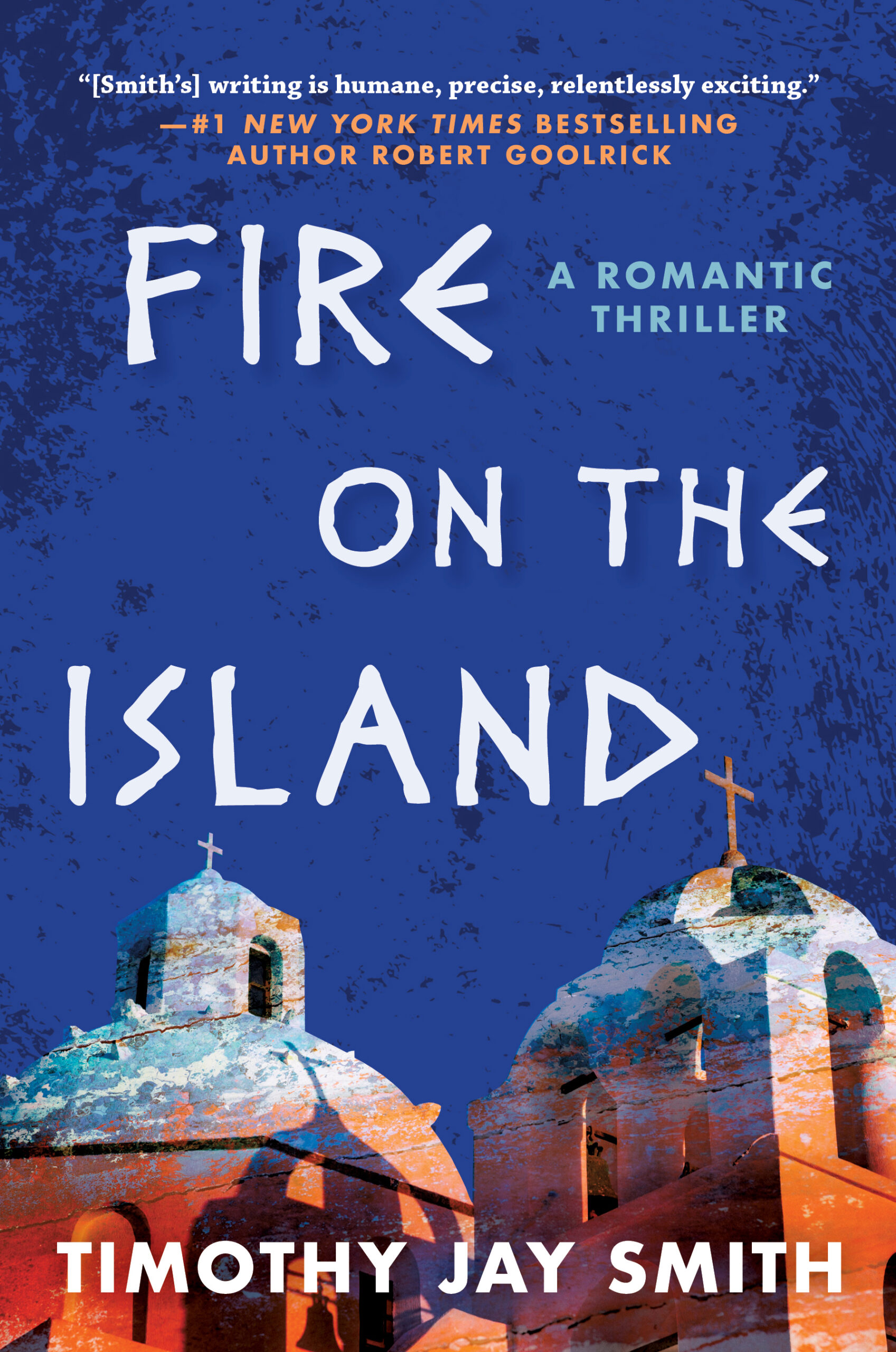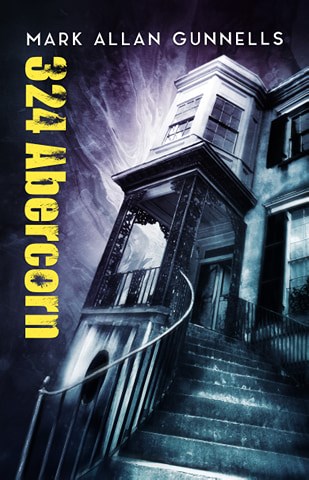
This week on The Scariest Part, my guest is Timothy Jay Smith, whose latest novel is Fire on the Island. Here is the publisher’s description:
Fire on the Island is a playful, romantic thriller set in contemporary Greece, with a gay Greek-American FBI agent, who is undercover on the island to investigate a series of mysterious fires. Set against the very real refugee crisis on the beautiful, sun-drenched Greek islands, this novel paints a loving portrait of a community in crisis. As the island residents grapple with declining tourism, poverty, refugees, family feuds, and a perilously damaged church, an arsonist invades their midst.
Nick Damigos, the FBI agent, arrives on the island just in time to witness the latest fire and save a beloved truffle-sniffing dog. Hailed as a hero and embraced by the community, Nick finds himself drawn to Takis, a young bartender who becomes his primary suspect, which is a problem because they’re having an affair. Theirs is not the only complicated romance in the community and Takis isn’t the only suspicious character on the island. The priest is an art forger, a young Albanian waiter harbors a secret, the captain of the coast guard station seems to have his own agenda, and the village itself hides a violent history. Nick has to unravel the truth in time to prevent catastrophe, as he comes to terms with his own past trauma. In saving the village, he will go a long way toward saving himself.
A long time devotee of the Greek islands, Smith paints the setting with gorgeous color and empathy, ushering in a new romantic thriller with the charm of Zorba the Greek while shedding bright light on the very real challenges of life in contemporary Greece.
And now, let’s hear what the scariest part was for Timothy Jay Smith:
My ancestors arrived in America in the tailwinds of the Mayflower. Like most early settlers, they spent their first few decades in the original thirteen colonies before joining the slow migration to the West. Where they eventually landed was Iowa — the Buckle of the Corn Belt — and for the next two hundred years, they placidly farmed that state’s low rolling hills, largely free of threats by wild animals or venomous bugs. A rare puma might be seen, the timber rattlesnakes stayed in woodlands away from people, and while spiders were plentiful, the black widow spiders were the only venomous ones, and even they were more likely to make you sick than kill you. It was a tranquil, rural, and safe environment.
All that changed for my parents when they decided to move to California; and not just anywhere in California, but to its southern desert replete with deadly snakes, reptiles with strange names and uncertain dangerous potential, huge hairy tarantulas as well as plenty of black widow spiders, and even benignly named ‘kissing bugs’ that promised agony and death.
Simply put: we had moved to a danger zone filled with threats big and small, where we could easily be killed if we weren’t always vigilant. Before getting into bed at night, we checked to make sure that an insect or snake hadn’t crawled into it first. When I became a little older, I was taught how to shoot a rifle if attacked by a mountain lion (there were many in the nearby canyons).
It wasn’t all paranoia. The dangers were real. We’d play in the desert surrounding our neighborhood, and frequently sink ankle-deep into rattlesnake holes. My dog was bitten by a sidewinder. A friend my age (probably ten) was bitten by a rattlesnake. He was lucky to have a pocketknife with him, and had the good sense to slice open the bite to suck out the venom. It saved his life. On another occasion, I came across a flat board, probably three-feet square, that I flipped over, disturbing dozens of spider nests. Black widows by the hundreds scattered in every direction, running across my shoes and climbing up my naked calves.
It was a moment so frightening that I never forgot it.
Fast forward to the present. I’m writing Fire on the Island, and my protagonist finds himself in a cemetery where he decides to upright a fallen tombstone. I flashed on turning over that board in the desert, so of course it’s black widow spiders that flee when the tombstone is disturbed, running over my character’s feet and up his legs. I shivered, recalling all those spiders on my legs many years ago.
But I couldn’t leave it at that, not if I were true to Chekhov’s Gun — the dramatic principle that every element in a story should be necessary and not make false promises by never coming into play. So what to do with black widow spiders?
The choice was remarkably easy. In Fire on the Island, an arsonist threatens a Greek island village, which would also put the local Coast Guard station out of commission during an uptick in the refugee crisis. Nick Damigos, the FBI agent assigned to Athens, arrives to investigate. The secret arsonist obviously doesn’t like that and decides to try to stop him.
Nick pulled back the bed covers, or tried to; they were tucked in tight. Athina must have returned to remake the bed sometime during the day. He yanked a corner loose enough to get between the sheets and jabbed his legs down to make room for his feet.
He was asleep before his head hit the pillow. Dreaming of nothing, and then suddenly he was in the sea, diving down, bubbles caught in the hair on his legs tickling him as they rose to the surface, drifting up his belly and chest. Then, a sting on his thigh, another on his shoulder; inconsequential pricks that his dreamer’s mind dismissed as jellyfish larvae in the warm water. They were annoying not painful. Nevertheless, he kicked his feet to swim faster, and the stinging became more intense.
He woke up with a start. Something was stinging him! Biting him and crawling all over him! He scrambled from bed and turned on the lamp, and flicked a spider off his arm. He saw its red belly. A black widow! He felt more tramping through the hair on his chest and brushed those off, and then knocked off the ones dangling by their fangs from his ankles. He ripped back the bed covers and saw the nests that his feet had disturbed.
Nick bolted for the bathroom, accidentally sending the bedside lamp crashing to the floor. He fished a pocketknife from his dopp kit and sat on the toilet slitting open the bites, pinching out blood and venom. He sucked on the ones he could reach and spat the foul mixture into the sink. By contorting himself in the mirror, he tried to open the bites on his back; but he couldn’t, not successfully before tremors set in. A nauseating dizziness swept over him. He slumped to the floor, closing the bathroom door with his body.
There you have it: the scariest part of Fire on the Island, coming right out of the pages of my childhood.
Fire on the Island: Amazon / Barnes & Noble / Powell’s / Bookshop
Timothy Jay Smith: Website / Facebook / Twitter / Instagram
Raised crisscrossing America pulling a small green trailer behind the family car, Timothy Jay Smith developed a ceaseless wanderlust that has taken him around the world many times. En route, he’s found the characters that people his work. Polish cops and Greek fishermen, mercenaries and arms dealers, child prostitutes and wannabe terrorists, Indian Chiefs and Indian tailors: he’s hung with them all in an unparalleled international career that saw him smuggle banned plays from behind the Iron Curtain, maneuver through Occupied Territories, represent the U.S. at the highest levels of foreign governments, and stowaway aboard a ‘devil’s barge’ for a three-day crossing from Cape Verde that landed him in an African jail.
Tim brings the same energy to his writing that he brought to a distinguished career, and as a result, he has won top honors for his novels, screenplays and stage plays in numerous prestigious competitions. Fire on the Island won the Gold Medal in the 2017 Faulkner-Wisdom Competition for the Novel (for unpublished novels), and his screenplay adaptation of it was named Best Indie Script by WriteMovies. Another novel, The Fourth Courier, set in Poland, published in 2019 by Arcade Publishing, was a finalist for Best Gay Novel in the 2020 Lambda Literary Awards. Previously, he won the Paris Prize for Fiction (now the Paris Literary Prize) for his novel, A Vision of Angels. Kirkus Reviews called Cooper’s Promise “literary dynamite” and selected it as one of the Best Books of 2012.
Tim was nominated for the 2018 Pushcart Prize. His stage play, How High the Moon, won the prestigious Stanley Drama Award, and his screenplays have won competitions sponsored by the American Screenwriters Association, WriteMovies, Houston WorldFest, Rhode Island International Film Festival, Fresh Voices, StoryPros, and the Hollywood Screenwriting Institute. He is the founder of the Smith Prize for Political Theater.
 Lovecraft Country by Matt Ruff
Lovecraft Country by Matt Ruff


